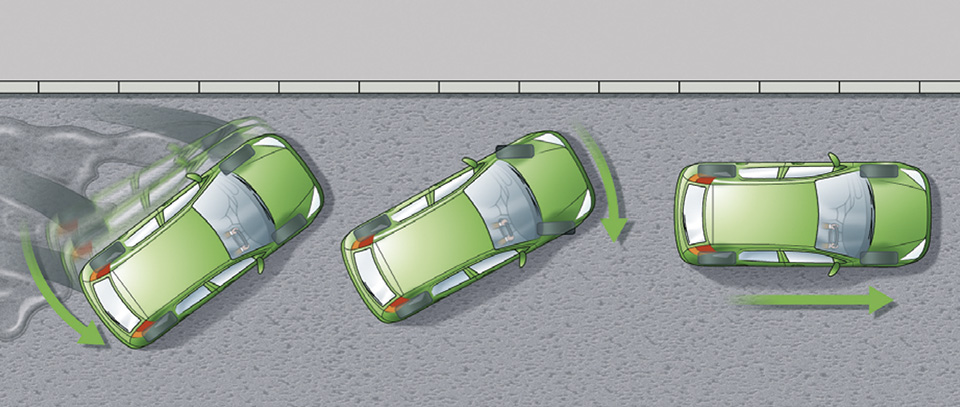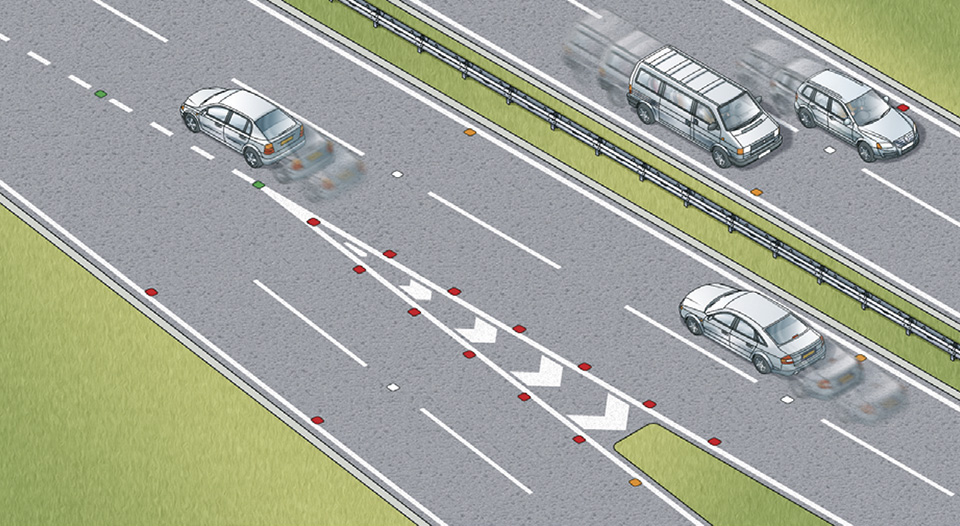Highway Code Rule 118
In an emergency. Brake immediately. Try to avoid braking so harshly that you lock your wheels. Locked wheels can lead to loss of control.
Highway Code Rule 119
Skids. Skidding is usually caused by the driver braking, accelerating or steering too harshly or driving too fast for the road conditions. If skidding occurs, remove the cause by releasing the brake pedal fully or easing off the accelerator. Turn the steering wheel in the direction of the skid. For example, if the rear of the vehicle skids to the right, steer immediately to the right to recover.
Highway Code Rule 120
ABS. If your vehicle is fitted with anti-lock brakes, you should follow the advice given in the vehicle handbook. However, in the case of an emergency, apply the footbrake firmly; do not release the pressure until the vehicle has slowed to the desired speed. The ABS should ensure that steering control will be retained, but do not assume that a vehicle with ABS will stop in a shorter distance.
Highway Code Rule 121
Brakes affected by water. If you have driven through deep water your brakes may be less effective. Test them at the first safe opportunity by pushing gently on the brake pedal to make sure that they work. If they are not fully effective, gently apply light pressure while driving slowly. This will help to dry them out.
Highway Code Rule 122
Coasting. This term describes a vehicle travelling in neutral or with the clutch pressed down. It can reduce driver control because
- engine braking is eliminated
- vehicle speed downhill will increase quickly
- increased use of the footbrake can reduce its effectiveness
- steering response will be affected, particularly on bends and corners
- it may be more difficult to select the appropriate gear when needed.
Highway Code Rule 123
The Driver and the Environment. You MUST NOT leave a parked vehicle unattended with the engine running or leave a vehicle engine running unnecessarily while that vehicle is stationary on a public road. Generally, if the vehicle is stationary and is likely to remain so for more than a couple of minutes, you should apply the parking brake and switch off the engine to reduce emissions and noise pollution. However it is permissible to leave the engine running if the vehicle is stationary in traffic or for diagnosing faults.
Law
Speed limits
| Speed Limits | Built-up areas* | Single carriageways | Dual carriageways | Motorways |
| Type of vehicle | mph (km/h) | mph (km/h) | mph (km/h) | mph (km/h) |
| Cars & motorcycles (including car derived vans up to 2 tonnes maximum laden weight) | 30 (48) | 60 (96) | 70 (112) | 70 (112) |
| Cars towing caravans or trailers (including car derived vans and motorcycles) | 30 (48) | 50 (80) | 60 (96) | 60 (96) |
| Buses, coaches and minibuses (not exceeding 12 metres in overall length) | 30 (48) | 50 (80) | 60 (96) | 70 (112) |
| Goods vehicles (not exceeding 7.5 tonnes maximum laden weight) | 30 (48) | 50 (80) | 60 (96) | 70† (112) |
| Goods vehicles (exceeding 7.5 tonnes maximum laden weight) in England and Wales | 30 (48) | 50 (80) | 60 (96) | 60 (96) |
| Goods vehicles (exceeding 7.5 tonnes maximum laden weight) in Scotland | 30 (48) | 40 (64) | 50 (80) | 60 (96) |
*The 30 mph limit usually applies to all traffic on all roads with street lighting unless signs show otherwise.
†60 mph (96 km/h) if articulated or towing a trailer.
Highway Code Rule 124
You MUST NOT exceed the maximum speed limits for the road and for your vehicle (see the speed limits table). The presence of street lights generally means that there is a 30 mph (48 km/h) speed limit unless otherwise specified.
Law
Highway Code Rule 125
The speed limit is the absolute maximum and does not mean it is safe to drive at that speed irrespective of conditions. Driving at speeds too fast for the road and traffic conditions is dangerous. You should always reduce your speed when
- the road layout or condition presents hazards, such as bends
- sharing the road with pedestrians, cyclists and horse riders, particularly children, and motorcyclists
- weather conditions make it safer to do so
- driving at night as it is more difficult to see other road users.
Highway Code Rule 126
Download ‘Typical stopping distances’ (PDF, 124KB)
Stopping Distances. Drive at a speed that will allow you to stop well within the distance you can see to be clear. You should
- leave enough space between you and the vehicle in front so that you can pull up safely if it suddenly slows down or stops. The safe rule is never to get closer than the overall stopping distance (see Typical Stopping Distances diagram, shown above)
- allow at least a two-second gap between you and the vehicle in front on roads carrying faster-moving traffic and in tunnels where visibility is reduced. The gap should be at least doubled on wet roads and increased still further on icy roads
- remember, large vehicles and motorcycles need a greater distance to stop. If driving a large vehicle in a tunnel, you should allow a four-second gap between you and the vehicle in front.
If you have to stop in a tunnel, leave at least a 5-metre gap between you and the vehicle in front.
Highway Code Rule 127
A broken white line. This marks the centre of the road. When this line lengthens and the gaps shorten, it means that there is a hazard ahead. Do not cross it unless you can see the road is clear and wish to overtake or turn off.
Highway Code Rule 128
Double white lines where the line nearest to you is broken. This means you may cross the lines to overtake if it is safe, provided you can complete the manoeuvre before reaching a solid white line on your side. White direction arrows on the road indicate that you need to get back onto your side of the road.
Highway Code Rule 129
Double white lines where the line nearest you is solid. This means you MUST NOT cross or straddle it unless it is safe and you need to enter adjoining premises or a side road. You may cross the line if necessary, provided the road is clear, to pass a stationary vehicle, or overtake a pedal cycle, horse or road maintenance vehicle, if they are travelling at 10 mph (16 km/h) or less.
Laws
Highway Code Rule 130
Areas of white diagonal stripes or chevrons painted on the road. These are to separate traffic lanes or to protect traffic turning right.
- If the area is bordered by a broken white line, you should not enter the area unless it is necessary and you can see that it is safe to do so.
- If the area is marked with chevrons and bordered by solid white lines you MUST NOT enter it except in an emergency.
Laws
Highway Code Rule 131
Lane dividers. These are short, broken white lines which are used on wide carriageways to divide them into lanes. You should keep between them.
Highway Code Rule 132
Reflective road studs may be used with white lines.
- White studs mark the lanes or the middle of the road.
- Red studs mark the left edge of the road.
- Amber studs mark the central reservation of a dual carriageway or motorway.
- Green studs mark the edge of the main carriageway at lay-bys and slip roads.
- Green/yellow studs indicate temporary adjustments to lane layouts, e.g. where road works are taking place.






